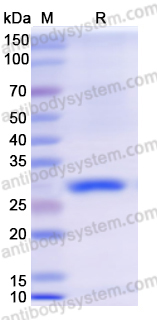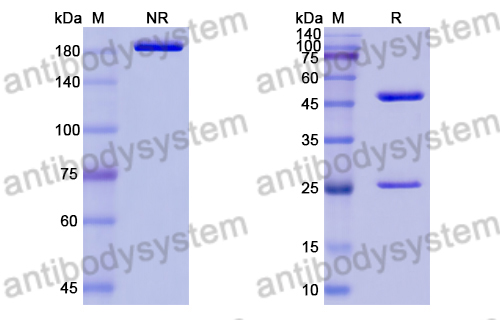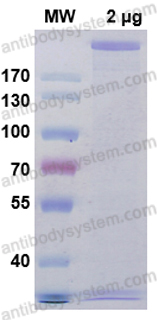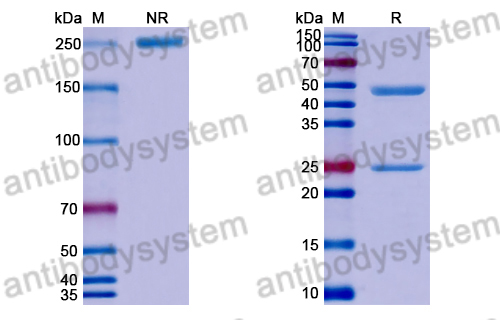Catalog No.
YXX06101
Expression system
E. coli
Species
Mycobacterium tuberculosis (strain ATCC 25618 / H37Rv)
Protein length
Met1-Gln70
Predicted molecular weight
33.93 kDa
Nature
Recombinant
Endotoxin level
Please contact with the lab for this information.
Purity
>90% as determined by SDS-PAGE.
Accession
P9WNK7
Applications
ELISA, Immunogen, SDS-PAGE, WB, Bioactivity testing in progress
Form
Lyophilized
Storage buffer
Lyophilized from a solution in PBS pH 7.4, 0.02% NLS, 1mM EDTA, 4% Trehalose, 1% Mannitol.
Reconstitution
Reconstitute in sterile water for a stock solution.
Shipping
In general, proteins are provided as lyophilized powder/frozen liquid. They are shipped out with dry ice/blue ice unless customers require otherwise.
Stability and Storage
Use a manual defrost freezer and avoid repeated freeze thaw cycles. Store at 2 to 8°C for frequent use. Store at -20 to -80°C for twelve months from the date of receipt.
Alternative Names
6 kDa early secretory antigenic target, ESAT-6, esxA, esaT6, Rv3875, MTV027.10
Exploring the Molecular Intersection of Posterior Ocular Tuberculosis: Mycobacterium tuberculosis Proteins, Ocular Autoimmunity, and Immune Receptor Interactions., PMID:40151358
Functional Analysis of Promoters, mRNA Cleavage, and mRNA Secondary Structure on esxB-esxA in Mycolicibacterium smegmatis., PMID:39770301
Mycobacterium bovis mutant in the virulence factors PhoP, ESAT-6 and CFP-10 persisted in mouse organs after a year post-vaccination., PMID:39509845
Mycobacterium tuberculosis VII secretion system effector molecule Rv2347c blocks the maturation of phagosomes and activates the STING/TBK1 signaling pathway to inhibit cell autophagy., PMID:39313213
The regulatory functions of ESX-1 substrates, EspE and EspF, are separable from secretion., PMID:39136451
The Presence of esat-6 and cfp10 and Other Gene Orthologs of the RD 1 Region in Non-Tuberculous Mycobacteria, Mycolicibacteria, Mycobacteroides and Mycolicibacter as Possible Impediments for the Diagnosis of (Animal) Tuberculosis., PMID:38930534
Analysis of the components of Mycobacterium tuberculosis heat-resistant antigen (Mtb-HAg) and its regulation of γδ T-cell function., PMID:38741147
N-terminal proteomics of Mycobacterium marinum using bottom-up label-free quantitative analysis in data-dependent acquisition mode on a timsTOF Pro mass spectrometer., PMID:38477461
Live attenuated Mycobacterium bovis strains combined with the encapsulated H65 antigen as a vaccine strategy against bovine tuberculosis in a mouse model., PMID:38335676
Discovery of dual-active ethionamide boosters inhibiting the Mycobacterium tuberculosis ESX-1 secretion system., PMID:38181799
Antibody reactivity to Mycobacterium tuberculosis-specific regions of differences 1 and regions of differences 9 proteins and peptides in rabbits, mice, and humans., PMID:38149542
Enrichment of Native and Recombinant Extracellular Vesicles of Mycobacteria., PMID:38145372
An N-acetyltransferase required for ESAT-6 N-terminal acetylation and virulence in Mycobacterium marinum., PMID:37772840
Chemical and Biological Characterization of Mycobacterium Tuberculosis-Specific ESAT6-Like Proteins and their Potentials in the Prevention of Tuberculosis and Asthma., PMID:37703836
An N-acetyltransferase required for EsxA N-terminal protein acetylation and virulence in Mycobacterium marinum., PMID:36993388
Development of Gold-Nanoparticle-Based Lateral Flow Immunoassays for Rapid Detection of TB ESAT-6 and CFP-10., PMID:36979566
Uptake-independent killing of macrophages by extracellular Mycobacterium tuberculosis aggregates., PMID:36920246
Recombinant Pichinde viral vector expressing tuberculosis antigens elicits strong T cell responses and protection in mice., PMID:36845108
Listeria-vectored multi-antigenic tuberculosis vaccine protects C57BL/6 and BALB/c mice and guinea pigs against Mycobacterium tuberculosis challenge., PMID:36539517
The ESX-1 Substrate PPE68 Has a Key Function in ESX-1-Mediated Secretion in Mycobacterium marinum., PMID:36409073
Differential activation of innate and adaptive lymphocytes during latent or active infection with Mycobacterium tuberculosis., PMID:35856253
Listeria-Vectored Multiantigenic Tuberculosis Vaccine Enhances Protective Immunity against Aerosol Challenge with Virulent Mycobacterium tuberculosis in BCG-Immunized C57BL/6 and BALB/c Mice., PMID:35642945
Mycobacterium tuberculosis EspK Has Active but Distinct Roles in the Secretion of EsxA and EspB., PMID:35315684
Early secreted antigenic target of 6 kda-like proteins of mycobacterium tuberculosis: Diagnostic and vaccine relevance., PMID:35295018
Interaction of Mycobacteria With Host Cell Inflammasomes., PMID:35237260
PD-L1 Expression in Monocytes Correlates with Bacterial Burden and Treatment Outcomes in Active Pulmonary Tuberculosis., PMID:35163542
Design of a peptide-based vaccine from late stage specific immunogenic cross-reactive antigens of PE/PPE proteins of Mycobacterium tuberculosis., PMID:34744006
ESX-5-targeted export of ESAT-6 in BCG combines enhanced immunogenicity & efficacy against murine tuberculosis with low virulence and reduced persistence., PMID:34420788
A Small Protein but with Diverse Roles: A Review of EsxA in Mycobacterium-Host Interaction., PMID:34209120
A Fluorescence Dequenching-based Liposome Leakage Assay to Measure Membrane Permeabilization by Pore-forming Proteins., PMID:34150932
Label-Free Comparative Proteomics of Differentially Expressed Mycobacterium tuberculosis Protein in Rifampicin-Related Drug-Resistant Strains., PMID:34063426
A comparative investigation on the role and interaction of EsxA and EsxB in host immune response., PMID:33691174
Mycobacterium tuberculosis EsxL induces TNF-α secretion through activation of TLR2 dependent MAPK and NF-κB pathways., PMID:33419561
Post-translational knockdown and post-secretional modification of EsxA determine contribution of EsxA membrane permeabilizing activity for mycobacterial intracellular survival., PMID:33356823
Association of disease severity with toll-like receptor polymorphisms in multidrug-resistant tuberculosis patients., PMID:33323653
Mycobacterium tuberculosis ESX-1-secreted substrate protein EspC promotes mycobacterial survival through endoplasmic reticulum stress-mediated apoptosis., PMID:33290182
TREM-1 enhances Mycobacterium tuberculosis-induced inflammatory responses in macrophages., PMID:33049389
Conserved ESX-1 Substrates EspE and EspF Are Virulence Factors That Regulate Gene Expression., PMID:32900815
High resolution CryoEM structure of the ring-shaped virulence factor EspB from Mycobacterium tuberculosis., PMID:32875288
Mycobacterial Virulence Factors: Surface-Exposed Lipids and Secreted Proteins., PMID:32498243
The ESX-1 Virulence Factors Downregulate miR-147-3p in Mycobacterium marinum-Infected Macrophages., PMID:32253249
Modification of a PE/PPE substrate pair reroutes an Esx substrate pair from the mycobacterial ESX-1 type VII secretion system to the ESX-5 system., PMID:32184351
Nα-Acetylation of the virulence factor EsxA is required for mycobacterial cytosolic translocation and virulence., PMID:32169899
Identification of scavenger receptor B1 as the airway microfold cell receptor for Mycobacterium tuberculosis., PMID:32134383
The effect of adjuvants and delivery systems on Th1, Th2, Th17 and Treg cytokine responses in mice immunized with Mycobacterium tuberculosis-specific proteins., PMID:32027660
Coordinate regulation of virulence and metabolic genes by the transcription factor HbhR in Mycobacterium marinum., PMID:31587365
EsxA mainly contributes to the miR-155 overexpression in human monocyte-derived macrophages and potentially affect the immune mechanism of macrophages through miRNA dysregulation., PMID:31561988
Effects of membrane lipid composition on Mycobacterium tuberculosis EsxA membrane insertion: A dual play of fluidity and charge., PMID:31430698
Morphology-based classification of mycobacteria-infected macrophages with convolutional neural network: reveal EsxA-induced morphologic changes indistinguishable by naked eyes., PMID:31287998
ESX Secretion-Associated Protein C From Mycobacterium tuberculosis Induces Macrophage Activation Through the Toll-Like Receptor-4/Mitogen-Activated Protein Kinase Signaling Pathway., PMID:31134163




